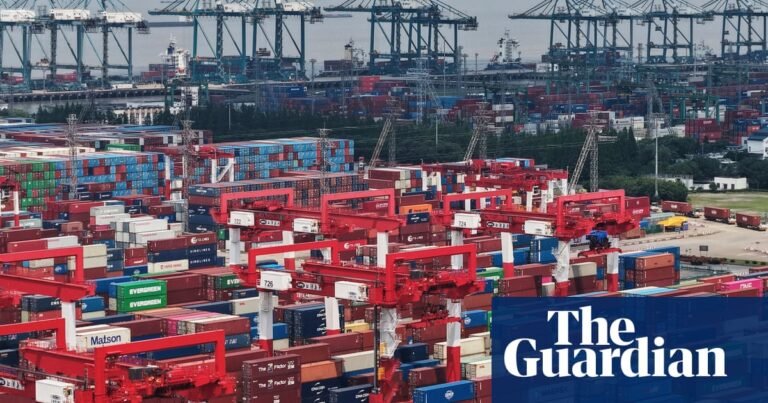Chinese exports to the UK jumped in May, according to data from Beijing, raising the prospect of a flood of cut-price goods as firms look for alternative markets to avoid Donald Trump’s tariffs.
Data published by the Chinese government showed a 16.1% increase in exports to the UK in May compared with the same month last year, hitting the highest level since February 2022.
That could be an early signal of an acceleration from the 10% annual rate of increase in April in the UK data published by the Office for National Statistics (ONS).
UK policymakers are watching closely for evidence that cheap Chinese imports that might once have been bound for the US are arriving in UK markets.
The Bank of England’s rate-setting monetary policy committee has suggested it could be a welcome factor bearing down on inflation in the coming months.
Sanjay Raja, a senior economist at Deutsche Bank, said: “Given lags in shipping, it’s possible that we may be seeing the start of a trend in higher imports from Asia … This could have important consequences for inflation.”
However, firms in some industries have expressed concerns about the prospect of Chinese products being “dumped” in the UK.
Chinese exports to UK graphic
The business secretary, Jonathan Reynolds, has backed immediate measures to keep tight control over import quotas, to prevent cheap Chinese steel flooding on to the UK market.
He will launch a six-week consultation on Thursday on how the UK can extend protections for the sector, which are due to expire in June next year.
Reynolds said: “We will not sit by idly while cheap imports threaten to undercut UK industry, so we are inviting industry to shape the next phase of our trade defences so we can provide robust support and ensure a fair and competitive market.”
The chancellor, Rachel Reeves, recently promised retailers she would review the low tax regime that allows parcels worth less than £135, often bought from websites such as Shein and Temu, to be imported free of customs duties.
Neil Shearing, the chief economist at the consultancy Capital Economics, said Chinese exports to the US dropped 34% year on year in May as tariffs on Beijing peaked, creating inevitable pressure to divert goods ultimately bound for the US via other countries, such as Vietnam or Cambodia, or to find new markets elsewhere.
“It’s the proverbial double-edged sword – and this is the essence of the challenges of globalisation,” he said.
skip past newsletter promotion
Sign up to Business Today
Get set for the working day – we’ll point you to all the business news and analysis you need every morning
Privacy Notice: Newsletters may contain info about charities, online ads, and content funded by outside parties. For more information see our Privacy Policy. We use Google reCaptcha to protect our website and the Google Privacy Policy and Terms of Service apply.
after newsletter promotion
“On the one hand, you have disinflation coming through imported goods, so that’s good for consumers. On the other hand, there’s extreme price competition for your exporters and your domestic industries.”
The US and China recently agreed a temporary trade truce, but tariffs on most Chinese goods entering the US market remain at a prohibitive 55%. It is unclear as yet whether Chinese exports to the US have begun to bounce back as a result of the pact.
Imports to the US from most other countries are subject to a 10% tariff, with the much higher “reciprocal” levies announced on Trump’s “liberation day” paused for 90 days until 9 July while trade negotiations continue.
The UK has struck the only deal agreed with the White House so far, which is due to lift punitive tariffs on cars and steel. The EU is locked in negotiations aimed at reducing the 50% levy Trump has threatened to impose on imports from the bloc.
Trump’s tariffs are expected to boost inflation in the US, where the Federal Reserve chair, Jerome Powell, cited the policy on Tuesday as a reason interest rates were unlikely to come down imminently, as the US president has demanded. The impact on inflation elsewhere is harder to predict, however.
The Bank of England governor, Andrew Bailey, has repeatedly pointed out that the future path for interest rates in the UK has become more uncertain as a result of the White House’s on-off tariffs.
